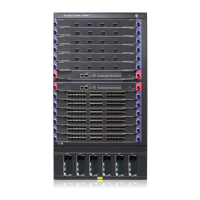349
• Configure an IGP on the PEs and Ps to ensure IP connectivity within the MPLS backbone.
• Configure basic MPLS for the MPLS backbone
• Configure MPLS LDP on PEs and Ps to establish LDP LSPs
Configuring VPN instances
By configuring VPN instances on a PE, you isolate not only VPN routes from public network routes, but
also routes of a VPN from those of another VPN. This feature allows VPN instances to be used in network
scenarios besides MPLS L3VPNs.
All VPN instance configurations are performed on PEs or MCEs.
Creating a VPN instance
A VPN instance is associated with a site. It is a collection of the VPN membership and routing rules of its
associated site. A VPN instance does not necessarily correspond to one VPN.
To create and configure a VPN instance:
Ste
Command
Remarks
1. Enter system view.
system-view N/A
2. Create a VPN instance and
enter VPN instance view.
ip vpn-instance vpn-instance-name
N/A
3. Configure an RD for the VPN
instance.
route-distinguisher
route-distinguisher
A VPN instance takes effect only
after you configure an RD for it.
4. Configure a description for
the VPN instance.
description text
Optional.
The description should contain the
VPN instance's related
information, such as its relationship
with a certain VPN.
Associating a VPN instance with an interface
After creating and configuring a VPN instance, you must associate the VPN instance with the interface
for connecting the CE. Any LDP-capable interface can be associated with a VPN instance. For
information about LDP-capable interfaces, see "Configuring basic MPLS."
T
o associate a VPN instance with an interface:
Ste
Command
Remarks
1. Enter system view.
system-view N/A
2. Enter interface view.
interface interface-type
interface-number
N/A
3. Associate a VPN instance
with the interface.
ip binding vpn-instance
vpn-instance-name
No VPN instance is associated
with an interface by default.
NOTE:
The ip binding vpn-instance command clears the IP address of the interface on which it is configured. Be
sure to re-configure an IP address for the interface after configuring the command.

